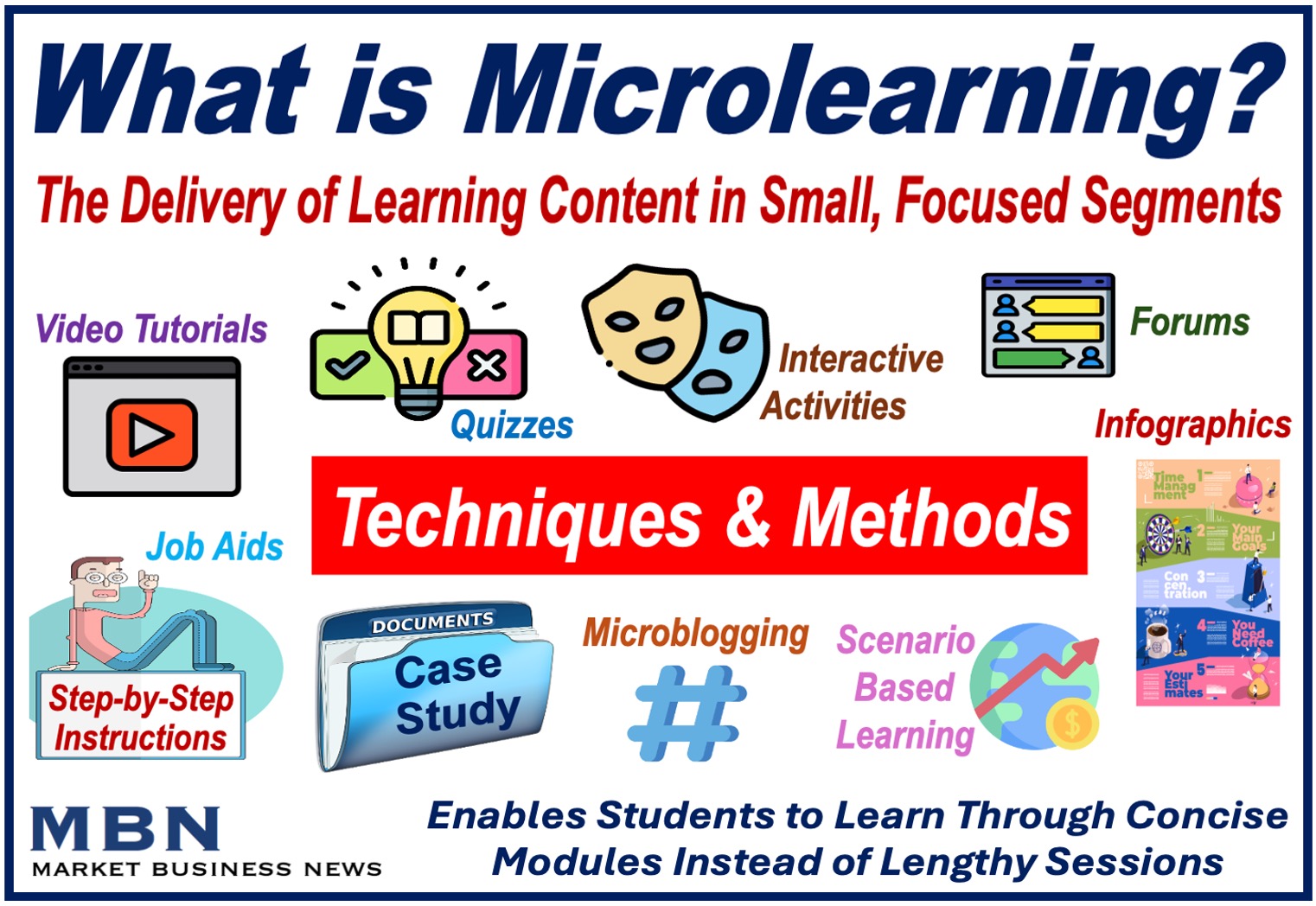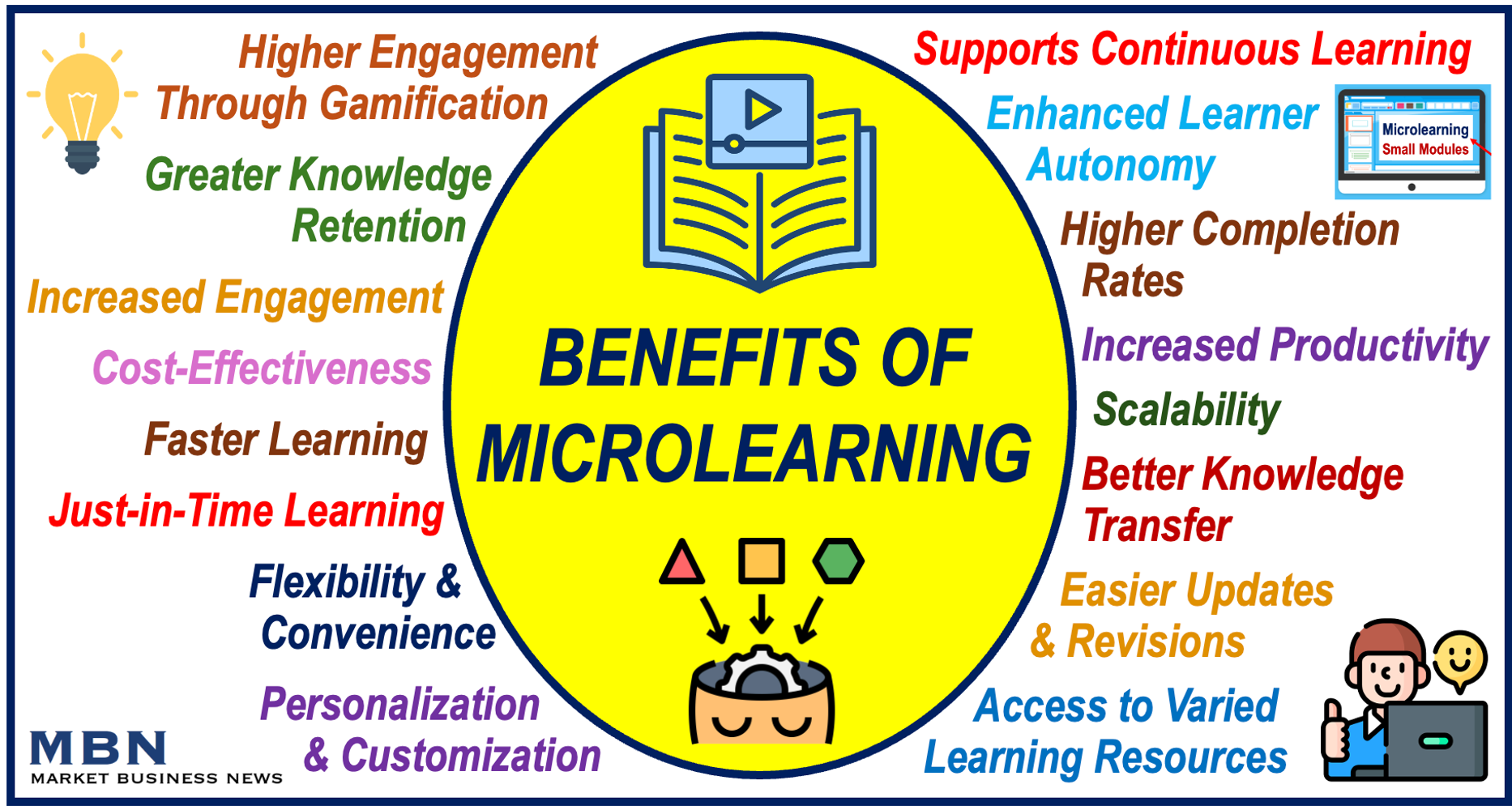Microlearning involves learning things in short bursts of content.
This could be in the form of an online course, a traditional classroom with a teacher present, or a specialized training program organized by an employer.
If it happens in your place of work, or is organized by your employer, we can also call it Microtraining.
In most cases, this type of learning occurs online; that is, it is a type of e-learning.
Microlearning aims to minimize learner fatigue by offering a set of compact e-learning modules.
The modules may be skill-based, professional, or educational. Each module, which has a single learning objective or topic, is not usually more than 5 to 20 minutes long – some learning centers insist on 5 to 10 minutes while other say they should be limited to 20 minutes.
Microlearning changes the way we gain knowledge and remember it.

Meanings of ‘Micro’ and ‘Learning’
Micro
The term ‘micro’ comes from the Greek word ‘micro,’ which means ‘small.’ There are many English words with the prefix ‘micro.’
Some examples include microscope (an instrument for viewing tiny objects), microbiology (the study of microscopic organisms), microchip (a tiny semiconductor), microsecond (one-millionth of a second), and microeconomics (the study of small-scale economic activities).
Some English words contain the prefix ‘mini,’ which means small in Latin. Examples include miniskirt, minibus, and minivan.
Learning
Learning refers to the activity of acquiring knowledge. A school or university, for example, are places of learning. The verb is ‘to learn’ and a person who is acquiring knowledge is a ‘learner.’
According to the Online Etymology Dictionary, the verb learn comes from the Old English word Leornian, which meant “to get knowledge, study, think about, read, or be cultivated.” Leornian originated from Old High German Lernen and Middle Dutch and Dutch Leeren and Lere, respectively.
The Rise and Evolution of Microlearning
As a concept, microlearning has existed in various forms for a long time – think of flashcards, short drills, or mini revision quizzes.
Most modern researchers of pedagogy (teaching methods) agree that Theo Hug, a professor at the Institute of Educational Studies at the University of Innsbruck (Austria), first theorized the microlearning approach in 2005.
According to Hug, people learn and remember more effectively if things are broken into small, manageable chunks.

Since 2005, microlearning has become increasingly popular globally, partly due to the widespread adoption of the Internet, digital tools, and mobile devices.
Online teaching centers and corporate trainers, especially, have become keen proponents of microlearning, recognizing its effectiveness in improving knowledge retention and engagement.
Benefits of Microlearning
Microlearning offers learners several advantages. Let’s have a look at some of them:
Greater Knowledge Retention
With microlearning, you acquire information in short, focused bursts. This is much easier for the human brain to process and remember. According to some studies, with this methodology, retention can improve by up to 80%.
Increased Engagement
As a learner, you are more likely to engage with short, interactive modules rather than long training sessions.
If these short bursts also include videos, quizzes, and interaction scenarios, you are much more likely to remain interested throughout each module.

Flexibility and Convenience
Microlearning allows you to access content and learn anytime and anywhere, especially if you have a mobile device like a smartphone or tablet.
This flexibility makes it easier to fit learning into a busy schedule.
Cost-Effectiveness
Short, reusable training modules are much cheaper to develop and deliver.
They eliminate the need for lengthy in-person training sessions, travel, and resource-hungry infrastructure.
Faster Learning
You can rapidly grasp key concepts and apply them without unnecessary details if the microlearning focuses on specific learning objectives.
Personalization and Customization
The educators or trainers can tailor each module to your specific needs and learning pace.
Adaptive learning technologies are digital systems or software that personalize content based on a learner’s progress and needs.
Just-in-Time Learning
A microlearning approach allows you to access information whenever you need it.
This is especially beneficial in the workplace, where you can quickly refresh your knowledge or acquire new skills just before applying them.
Increased Productivity
Short, focused training sessions minimize disruption in daily tasks, allowing you to keep up with training without affecting your productivity.
In most cases, this integration into daily routines leads to an overall productivity boost.
Higher Completion Rates
You are less likely to drop out of your course if it consists of short bursts of information. In other words, you are more likely to complete a course that consists of small modules, compared to traditional long form training sessions.
Supports Continuous Learning
Microlearning promotes a culture of continuous learning by offering ongoing, bite-sized training opportunities.
This can help you stay up-to-date with new skills and industry trends without feeling overwhelmed.
Microlearning Techniques and Methods
In the microlearning approach, there are several techniques and methods to keep the learner focused and engaged. Here are ten common approaches:
Video Tutorials
These consist of short educational videos that focus on a specific theme or skill and typically last from two to five minutes.
These videos present information in a visually engaging format, making them ideal for quick demonstrations or explanations.
Quizzes and Assessments
Brief, targeted quizzes help reinforce key concepts. They allow you to test your understanding immediately after learning new content. In other words, they are great for revision and checking progress.
Flashcards
Most of us remember flashcards from our school days, especially in primary school, and perhaps in foreign language lessons in secondary school.
Digital or physical cards with questions on one side and answers on the other are great learning tools.
Flashcards are effective for memorizing facts, definitions, or language vocabulary through spaced repetition.
Interactive Activities
These include games, simulations, role-playing scenarios, branching activities, or decision-making exercises that actively engage the learner, making the learning process more immersive and memorable.
Scenario-Based Learning
You are presented with real-life scenarios where you must make decisions and suffer or enjoy the consequences.
This approach is particularly useful for developing problem-solving and critical thinking skills.
Infographics
Infographics are visual representations that summarize information in a concise and engaging format. They are great for presenting statistics, processes, or key points at a glance.
Podcasts and Audio Lessons
Short audio segments allow you to consume information while on the go. These are ideal if you are an auditory learner (someone who learns via hearing).
You can learn in various situations, such as during your commute or while resting under a palm tree on vacation.
Mini Case Studies
Short, focused narratives of real-life examples that help illustrate complex concepts or business strategies, allowing you to connect theory to practical scenarios.
Job Aids and Cheat Sheets
Handy, one-page guides that summarize essential information or provide step-by-step instructions are great for quick reference or just-in-time support.
Microblogging and Discussion Threads
These consist of short blog posts or forums where you can engage with key ideas, ask questions, and receive peer or expert feedback.
This method promotes collaborative learning and knowledge sharing.
Examples of Microlearning in Practice
Workplaces
Microlearning is commonly used in the workplace for new employees, compliance training.
For example, an employer may use bite-sized videos and quizzes to train new hires or update staff on policies.
Education
E-learning platforms like Coursera, Khan Academy, edX, Udemy, and LinkedIn Learning utilize micro-courses and brief assessments to simplify complex subjects and reinforce learning.
Professional Development
Professional training also benefits from microlearning through skill-based certifications.
Digital Skills Training
Companies like Google, Microsoft, and IBM offer micro-courses to teach in-demand digital skills, providing interactive scenarios for hands-on experience.
Challenges and Limitations
Like everything in life, microlearning comes with its own set of drawbacks and limitations. Here are ten key challenges to consider:
Oversimplification of Complex Topics
Microlearning focuses on short modules, which can sometimes oversimplify complex subjects, making it harder to grasp deeper concepts.
Lack of Context
You may sometimes not fully understand the material because the modules are too small to provide enough context or background.
Fragmented Learning Experience
You might find it challenging to connect the dots between multiple small lessons, resulting in a disjointed learning journey.
The creators of the learning material need to be careful and make sure this does not happen.
Limited Skill Development
Certain skills, particularly those requiring deep understanding or hands-on practice, may not be fully developed through brief lessons alone.
High Self-Discipline Requirement
In most cases, it is up to you when you learn. This learning approach relies on you, the learner, to take responsibility for your progress. This requires self-discipline and motivation to stay on track.
Are you the type of person who can keep going under your own steam, or do you need someone there to supervise, discipline, and motivate you?
Difficulty in Measuring Long-Term Impact
The brief nature of microlearning makes it challenging to assess its long-term effectiveness and retention of information.
Not Suitable for All Subjects
There are some fields that require comprehensive instruction and detailed explanations. Examples include engineering, medicine, and most other sciences.
Risk of Cognitive Overload
Frequent exposure to multiple small modules can sometimes lead to cognitive overload, particularly if you are bombarded with too much information in a short period.
Dependence on Technology
Microlearning heavily relies on digital tools and platforms, which could be a barrier for learners without reliable internet access or tech skills.
If there is a power cut, your modem stops working, or your equipment is faulty, you cannot study.
Limited Collaboration and Interaction
In microlearning, you typically acquire knowledge and skills on your own. There are minimal opportunities for peer-to-peer collaboration or interaction.
According to researchers at the University of Brunei Darussalam, a qualitative analysis of microlearning revealed several challenges, such as limited opportunities for peer interaction, a fast-paced delivery that can hinder comprehension of complex topics. However, it also highlighted key benefits like greater flexibility and improved accessibility.
Future Trends in Microlearning
Artificial Intelligence (AI)
AI is dramatically changing how we work, search for information, enjoy ourselves, and solve problems. Education, including microlearning, is no exception.
Apart from making learning more engaging and efficient, AI will probably address and solve many of the challenges associated with microlearning.
Virtual Reality (VR)
Immersive VR-based microlearning experiences are becoming more prominent, offering realistic simulations for hands-on practice. We can only imagine what this type of learning will be like in twenty or thirty years’ time.
Gamification
Gamification involves adding game-design components to something that is not a game to make it more interesting or engaging.
More and more educators are including gamification in their course materials to boost student engagement, motivation, and learning.
Let’s recap. Microlearning is an educational approach that delivers information in small, focused, bite-sized chunks, making it easier to process and remember.
Over the past few decades, it has become increasingly popular, partly due to its flexibility, cost-effectiveness, and ability to boost engagement, and also due to the widespread adoption of the internet, computers, smartphones, and tablets.
Techniques like video tutorials, quizzes, and interactive activities make it diverse and engaging.
While it has many benefits, microlearning also comes with challenges, such as potential oversimplification and reliance on technology.
Innovations like AI, VR, and gamification are poised to enhance its effectiveness, making microlearning a key trend in modern education and training.
